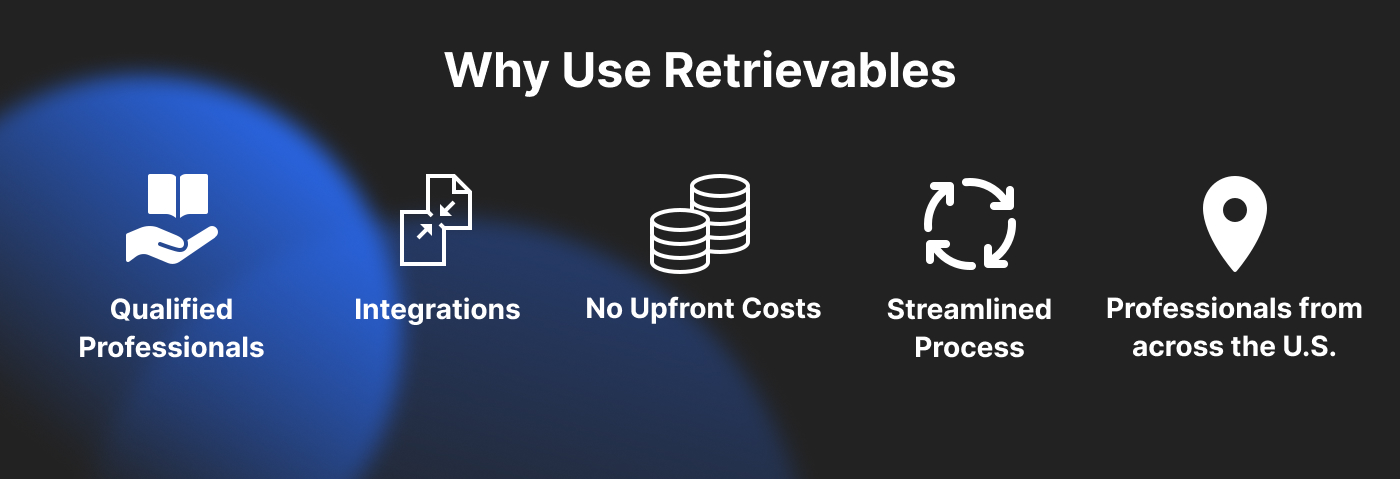How to Improve Cash Flow with Automated Receivables Management
Updated November 6th 2025

Table of Contents
- Introduction
- Understanding Automated Receivables Management
- The Connection Between Automation and Cash Flow
- Common Cash Flow Challenges in Large Enterprises
- The Role of Automation in the Invoicing Process
- Proactive Payment Reminders and Predictive Alerts
- Data Insights: Turning Receivables into Strategic Intelligence
- Integrating Automation with Existing Systems
- Enhancing Collections with Automation
- How Retrievables Enhances Receivables Recovery
- Case Study: Automation and Recovery in Action
- Building a Culture of Cash Flow Discipline
- The ROI of Automated Receivables
- Future Trends in Receivables Automation
- FAQs
- Conclusion: Combining Automation and Expertise for Stronger Cash Flow
Cash flow keeps a business alive. It fuels growth, supports operations, and ensures that opportunities aren’t lost to liquidity crunches. Yet, even profitable companies often face cash flow issues—not because they lack revenue, but because they struggle to collect what’s owed to them on time.
Enter automated receivables management—a transformative tool for entrepreneurs, finance leaders, and enterprise managers who want to take control of their working capital. Automation in receivables helps eliminate inefficiencies, reduce manual errors, and, most importantly, accelerate cash inflow.
Let’s explore how businesses can improve their cash flow with automation and how Retrievables empowers organizations to recover overdue receivables by connecting them with the most suitable collection attorneys or agencies.
Understanding Automated Receivables Management
At its core, automated receivables management is the use of software and AI-driven systems to streamline every stage of the accounts receivable process—from invoice generation to payment reconciliation and debt recovery.
Instead of manually tracking payments, sending reminders, and reconciling ledgers, automation tools can:
- Generate and send invoices instantly
- Track payment statuses in real time
- Trigger automated reminders for overdue invoices
- Predict payment delays using data analytics
- Integrate with accounting systems for seamless reconciliation
In short, automation turns receivables from a reactive, manual task into a proactive, data-driven process.

The Connection Between Automation and Cash Flow
Cash flow issues often arise from delayed payments, inefficient invoicing, and poor follow-up. Automation addresses these challenges head-on.
- Faster invoicing means faster payments. When invoices are automatically generated and sent immediately after goods or services are delivered, payment cycles shrink.
- Real-time visibility reduces uncertainty. Automated dashboards give finance teams instant insights into outstanding payments and customer credit risk.
- Fewer disputes, fewer delays. Automation minimizes human error, leading to fewer billing disputes and quicker resolutions.
By tightening the cycle between delivery and payment, businesses maintain steadier cash flow and can allocate resources more strategically.
Common Cash Flow Challenges in Large Enterprises
Even large enterprises with sophisticated finance teams face recurring cash flow obstacles:
- Slow-paying customers: Corporate clients often operate on long payment terms (30–90 days or more), creating gaps in cash inflow.
- Inefficient collections: Manual follow-ups consume valuable staff time and yield inconsistent results.
- Poor data integration: Disconnected accounting, CRM, and payment systems lead to errors and lack of visibility.
- Limited escalation strategy: Without structured escalation to collection agencies or legal partners, overdue accounts linger unresolved.
These challenges directly impact liquidity and profitability. Automation provides a structured, measurable solution to overcome them.
The Role of Automation in the Invoicing Process
Automated receivables systems can revolutionize invoicing—a process that’s traditionally been a major bottleneck.
- Automatic invoice creation: Once a sale is completed, an invoice is instantly generated using stored templates and customer data.
- Multi-channel delivery: Invoices can be sent automatically via email, customer portals, or integrated accounting systems.
- Error-free calculations: Automated tax and discount rules reduce human mistakes that can trigger disputes.
- Tracking and confirmation: The system can confirm receipt of the invoice and monitor whether it’s been viewed by the recipient.
Result: shorter billing cycles, fewer disputes, and smoother cash flow.
Proactive Payment Reminders and Predictive Alerts
Manual reminders are easy to forget or inconsistently executed. Automation ensures that every overdue invoice is followed up consistently and professionally.
- Customizable reminders: Automated systems can send reminders before, on, and after due dates, adjusting tone and frequency.
- AI-driven predictions: Machine learning models can forecast which customers are likely to pay late, enabling proactive communication or adjusted credit terms.
- Escalation workflows: When payments remain overdue, systems can trigger internal alerts or escalate the case to external partners like Retrievables for commercial debt recovery.
Automation not only saves time but also preserves customer relationships by ensuring that reminders are polite, timely, and consistent.

Data Insights: Turning Receivables into Strategic Intelligence
Receivables data, when analyzed effectively, can reveal deep insights into customer behavior, credit risk, and cash flow trends.
Automation tools can generate dashboards that answer vital questions like:
- Which customers frequently delay payments?
- What industries or regions have the highest default rates?
- How do seasonal patterns affect collections?
These insights allow managers to refine credit policies, forecast revenue more accurately, and identify high-risk clients before problems escalate.
Integrating Automation with Existing Systems
One common hesitation among enterprises is the fear that automation will disrupt existing accounting systems. However, modern receivables solutions integrate seamlessly with popular ERP (Enterprise Resource Planning) and CRM (Customer Relationship Management) platforms.
For example:
- Integration with accounting tools like QuickBooks, Xero, or SAP ensures real-time synchronization.
- Payment gateways like Stripe or PayPal can be linked for automatic payment matching.
- CRM integration helps sales and finance teams align on customer payment history and follow-ups.
This interoperability makes adoption smoother and minimizes the learning curve for internal teams.
Enhancing Collections with Automation
Even with best-in-class invoicing and reminders, some customers will inevitably default. Automation strengthens the collections process by:
- Automatically flagging overdue accounts based on preset criteria
- Tracking communication and documentation for compliance
- Prioritizing accounts by likelihood of recovery
- Streamlining the escalation to third-party recovery specialists
This last point is where Retrievables plays a crucial role—ensuring businesses don’t just manage receivables, but actively recover them when standard methods fail.
How Retrievables Enhances Receivables Recovery
Retrievables is a platform designed specifically for commercial debt collection—helping businesses connect with the right collection attorney or agency for their unique situation.
Here’s how Retrievables fits into your automated receivables strategy:
- Intelligent matching: Retrievables uses data to match your case with the most qualified collection expert based on industry, location, and claim size.
- Efficiency: Instead of spending weeks researching or negotiating with multiple agencies, you can find a trusted professional instantly.
- Transparency: You can compare potential collection partners, review performance data, and make informed choices.
- Legal escalation: If amicable recovery fails, Retrievables helps you find specialized collection attorneys who understand commercial law nuances.
In essence, Retrievables bridges the gap between automation and effective human expertise—making debt recovery more strategic and efficient.

Case Study: Automation and Recovery in Action
Imagine a manufacturing enterprise with hundreds of B2B customers. Despite strong sales, the company struggles with late payments—tying up millions in unpaid invoices.
After implementing automated receivables software and integrating with Retrievables, they achieved:
- 40% faster average payment turnaround
- 30% reduction in overdue accounts
- Significant time savings for the finance team
- Improved recovery rates for delinquent invoices through expert collection partners
The combination of automation + strategic recovery transformed cash flow stability and empowered growth planning.
Building a Culture of Cash Flow Discipline
Automation is a tool—but sustainable cash flow improvement also requires cultural change.
Businesses should:
- Prioritize cash flow KPIs alongside revenue metrics
- Train teams to use automation tools effectively
- Establish clear policies for credit terms and escalation procedures
- Encourage collaboration between sales, finance, and operations
Technology amplifies discipline; it doesn’t replace it.
The ROI of Automated Receivables
The return on investment from automation comes in multiple forms:
- Reduced Days Sales Outstanding (DSO) – meaning cash hits your account faster.
- Lower operational costs – fewer manual hours spent chasing payments.
- Higher accuracy – fewer disputes and write-offs.
- Better forecasting – finance teams can plan investments with confidence.
For enterprises managing millions in receivables, even a 5–10% improvement in DSO can unlock substantial working capital.
Future Trends in Receivables Automation
Receivables automation continues to evolve rapidly, with emerging trends including:
- AI-driven risk scoring for customers based on historical data
- Smart contracts using blockchain to enforce payment terms automatically
- Embedded finance integrations that offer early payment options to customers
- Predictive cash flow analytics for strategic decision-making
Businesses that adopt these technologies early will enjoy a competitive edge in financial agility.
FAQs
What is automated receivables management?
It’s the use of technology to automate tasks like invoicing, reminders, and payment tracking, reducing manual effort and improving cash flow.
How does automation improve cash flow?
Automation accelerates payments, reduces errors, and improves visibility—helping businesses collect money faster and manage working capital efficiently.
Is automation suitable for large enterprises?
Absolutely. Large enterprises with complex billing cycles benefit significantly from automation’s scalability and integration capabilities.
What happens when automation can’t collect overdue debts?
That’s where platforms like Retrievables step in—connecting you with expert collection agencies or attorneys for professional recovery.
How does Retrievables select collection partners?
Retrievables uses an intelligent matching system that considers your industry, debt type, and claim size to pair you with the most qualified professional.
Can automation harm customer relationships?
Not if implemented correctly. Automated reminders can be personalized and polite, maintaining professionalism while ensuring prompt payments.
Conclusion: Combining Automation and Expertise for Stronger Cash Flow
Automated receivables management transforms how businesses handle cash flow—turning a once-frustrating process into a predictable, efficient system. But when automation alone can’t recover outstanding debts, Retrievables bridges the gap with expert human intervention.
By combining technology and specialized expertise, companies can not only prevent cash flow problems but also resolve them swiftly and effectively. For entrepreneurs and enterprise leaders alike, this integrated approach ensures liquidity, growth, and resilience—today and into the future.
Updated November 6th 2025
Author: Jeremy Crane
Find an attorney and get your invoices paid
Register on the platform and enter information about past due accounts